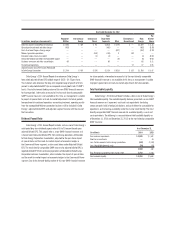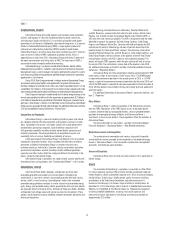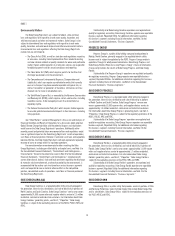Duke Energy 2014 Annual Report Download - page 26
Download and view the complete annual report
Please find page 26 of the 2014 Duke Energy annual report below. You can navigate through the pages in the report by either clicking on the pages listed below, or by using the keyword search tool below to find specific information within the annual report.
PART I
6
ITEM 1. BUSINESS
DUKE ENERGY
General
Duke Energy Corporation (collectively with its subsidiaries, Duke Energy)
is an energy company headquartered in Charlotte, North Carolina, subject to
regulation by the Federal Energy Regulatory Commission (FERC). Duke Energy
operates in the United States (U.S.) and Latin America primarily through
its direct and indirect subsidiaries. Duke Energy’s subsidiaries include its
subsidiary registrants (collectively referred to as the Subsidiary Registrants);
Duke Energy Carolinas, LLC (Duke Energy Carolinas); Progress Energy, Inc.
(Progress Energy); Duke Energy Progress, Inc. (Duke Energy Progress); Duke
Energy Florida, Inc. (Duke Energy Florida); Duke Energy Ohio, Inc. (Duke Energy
Ohio); and Duke Energy Indiana, Inc. (Duke Energy Indiana). When discussing
Duke Energy’s consolidated fi nancial information, it necessarily includes
the results of its Subsidiary Registrants, which along with Duke Energy, are
collectively referred to as the Duke Energy Registrants.
On August 21, 2014, Duke Energy entered into an agreement to sell its
nonregulated Midwest generation business (Disposal Group) to Dynegy Inc.
(Dynegy) for approximately $2.8 billion in cash subject to adjustments at closing
for changes in working capital and capital expenditures. The Disposal Group
primarily includes Duke Energy Ohio’s coal-fi red and gas-fi red generation
assets located in the Midwest region of the United States and dispatched into
the PJM wholesale market. These assets earn energy and capacity revenue at
market price. The Disposal Group also includes a retail sales subsidiary of Duke
Energy, Duke Energy Retail Sales, LLC (Duke Energy Retail), which is certifi ed
as a Competitive Retail Electric Supplier (CRES) provider in Ohio. Duke Energy
Retail serves retail electric and gas customers in Ohio with energy and provides
other energy services at competitive rates. Completion of the transaction is
conditioned on approval by FERC. The transaction is expected to close by the
end of the second quarter of 2015. For additional information on the Midwest
generation business disposition see Note 2 to the Consolidated Financial
Statements, “Acquisitions, Dispositions and Sales of Other Assets.”
The Duke Energy Registrants electronically fi le reports with the Securities
and Exchange Commission (SEC), including annual reports on Form 10-K,
quarterly reports on Form 10-Q, current reports on Form 8-K, proxies and
amendments to such reports.
The public may read and copy any materials the Duke Energy Registrants
fi le with the SEC at the SEC’s Public Reference Room at 100 F Street, NE,
Washington, DC 20549. The public may obtain information on the operation of
the Public Reference Room by calling the SEC at 1-800-SEC-0330. The SEC
also maintains an Internet site that contains reports, proxy and information
statements, and other information regarding issuers that fi le electronically with
the SEC at http://www.sec.gov. Additionally, information about the Duke Energy
Registrants, including reports fi led with the SEC, is available through Duke
Energy’s website at http://www.duke-energy.com. Such reports are accessible
at no charge and are made available as soon as reasonably practicable after
such material is fi led with or furnished to the SEC.
Business Segments
Duke Energy conducts its operations in three business segments;
Regulated Utilities, International Energy and Commercial Power. The remainder
of Duke Energy’s operations are presented as Other. Duke Energy’s chief
operating decision maker regularly reviews fi nancial information about each of
these business segments in deciding how to allocate resources and evaluate
performance. For additional information on each of these business segments,
including fi nancial and geographic information, see Note 3 to the Consolidated
Financial Statements, “Business Segments.”
The following sections describe the business and operations of each of
Duke Energy’s reportable business segments, as well as Other.
REGULATED UTILITIES
Regulated Utilities conducts operations primarily through Duke Energy
Carolinas, Duke Energy Progress, Duke Energy Florida, Duke Energy Indiana and
Duke Energy Ohio. These electric and gas operations are subject to the rules
and regulations of the FERC, the North Carolina Utilities Commission (NCUC),
the Public Service Commission of South Carolina (PSCSC), the Florida Public
Service Commission (FPSC), the Indiana Utility Regulatory Commission (IURC),
the Public Utilities Commission of Ohio (PUCO), and the Kentucky Public Service
Commission (KPSC).
Regulated Utilities serves 7.3 million retail electric customers in six
states in the Southeast and Midwest regions of the U.S. Its service area
covers approximately 95,000 square miles with an estimated population
of 23 million people. Regulated Utilities serves 500,000 retail natural gas
customers in southwestern Ohio and northern Kentucky. Electricity is also sold
wholesale to incorporated municipalities, electric cooperative utilities and
other load-serving entities.
The following table represents the distribution of billed sales by customer class for the year ended December 31, 2014.
Duke
Energy
Carolinas(a)
Duke
Energy
Progress(a)
Duke
Energy
Florida(b)
Duke
Energy
Ohio(c)
Duke
Energy
Indiana(d)
Residential 32% 29% 49% 36% 28%
General service 32% 24% 39% 39% 25%
Industrial 25% 16% 8% 24% 32%
Total retail sales 89% 69% 96% 99% 85%
Wholesale and other sales 11% 31% 4% 1% 15%
Total sales 100% 100% 100% 100% 100%
(a) Primary general service sectors include health care, education, fi nancial services, information technology and military buildings. Primary industrial sectors include textiles, chemicals, rubber and plastics, paper, food and
beverage, and auto manufacturing.
(b) Primary general service sectors include tourism, health care and government facilities and schools. Primary industrial sectors include phosphate rock mining and processing and citrus and other food processing.
(c) Primary general service sectors include health care, education, real estate and rental leasing, fi nancial and insurance services, water/wastewater services, and wholesale trade services. Primary industrial sectors include
aerospace, primary metals, chemicals and food.
(d) Primary general service sectors include retail, fi nancial, health care and education services. Primary industrial sectors include primary and fabricated metals, transportation equipment, building materials, food and beverage,
stone/clay/glass, and chemicals.
























